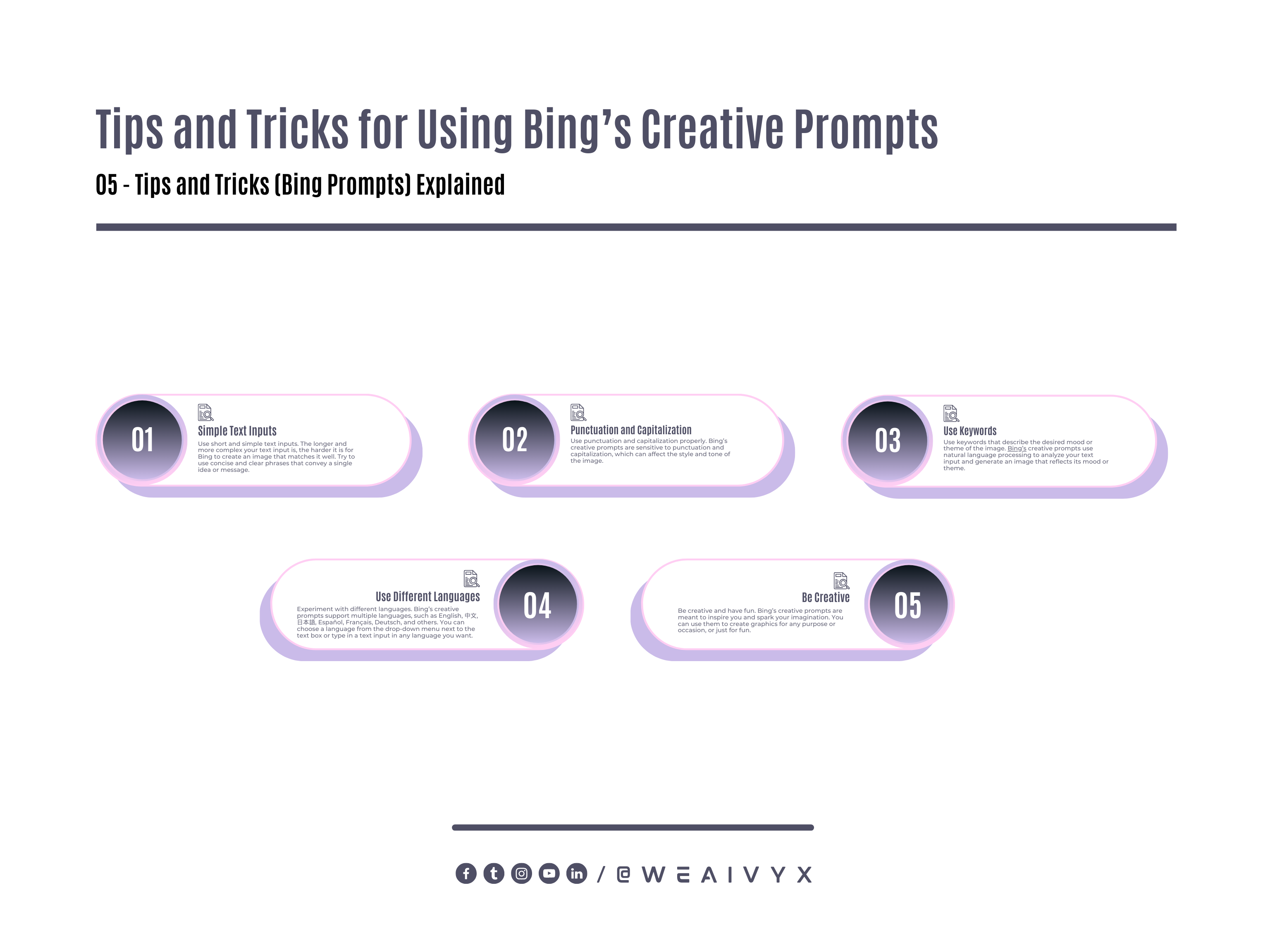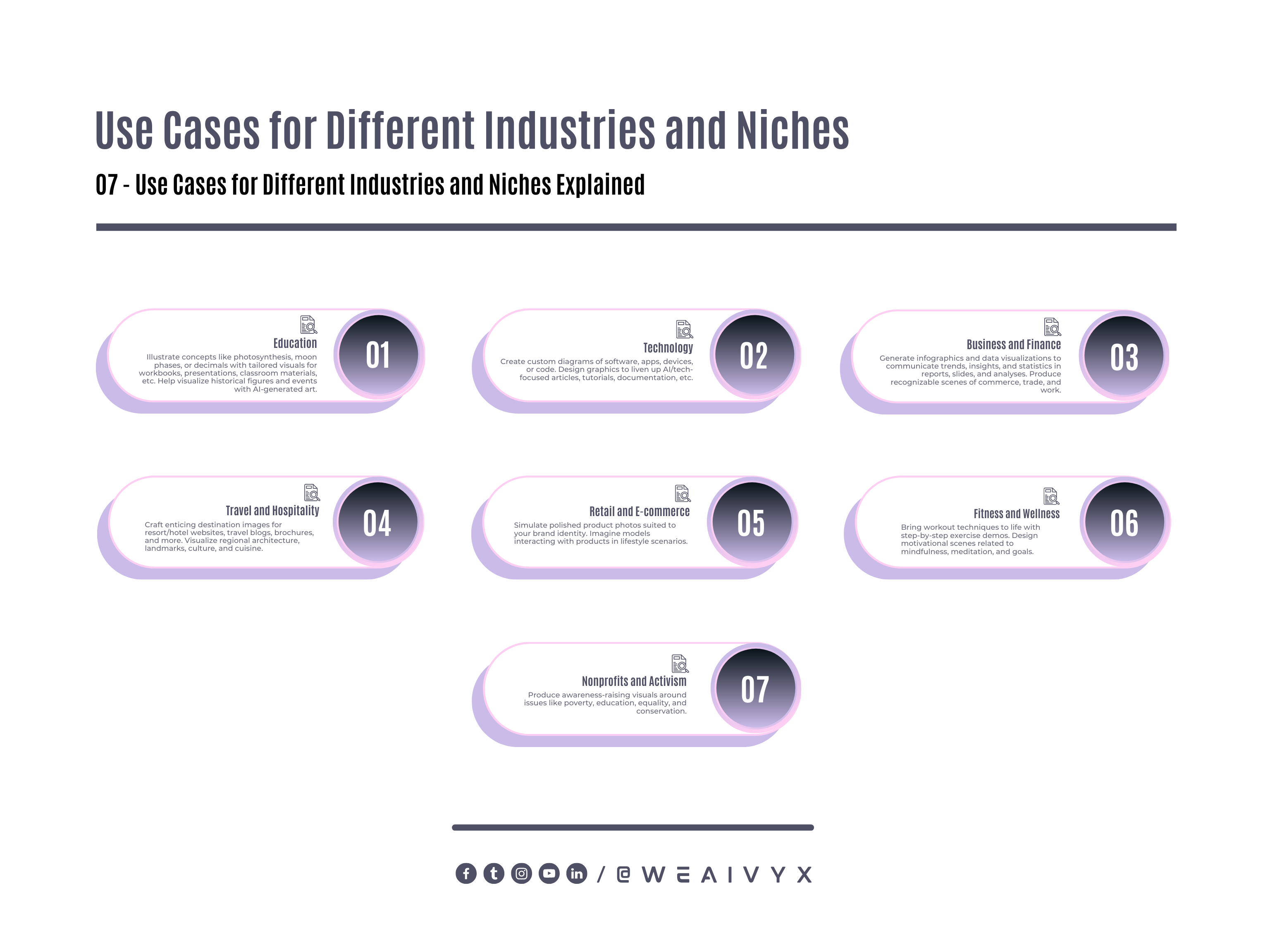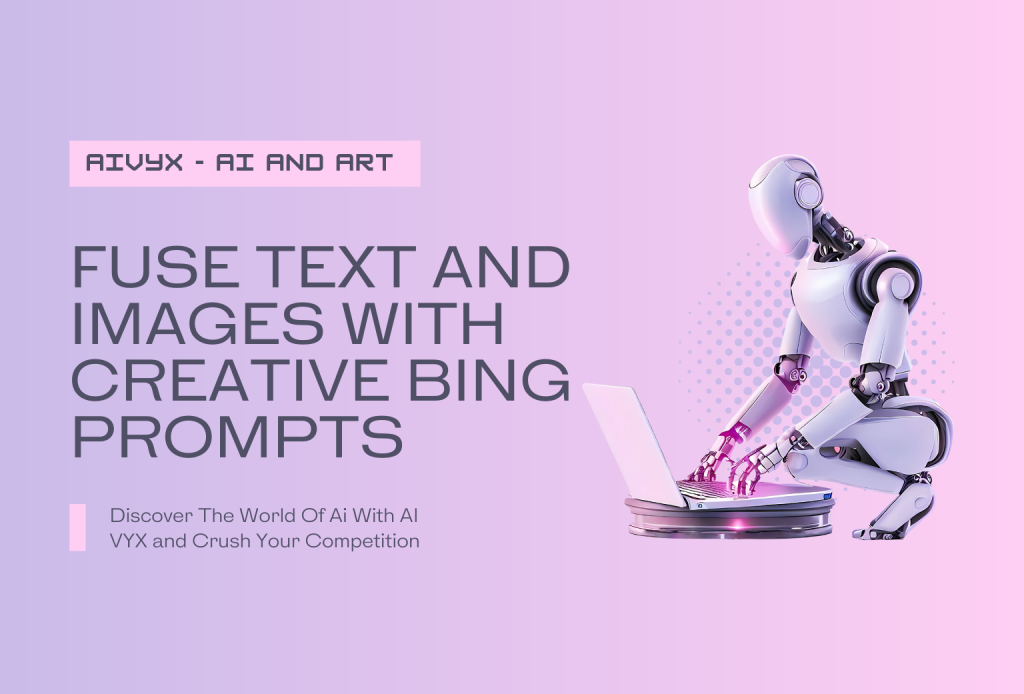Have you ever wanted to create stunning graphics that creatively combine text and images?
Do you wish you could generate unique and engaging content for your blog, social media, or website without spending hours on Photoshop or Illustrator?
If so, you might be interested in learning how to use Bing’s creative prompts to fuse text and images with artificial intelligence.
Bing’s creative prompts are a feature that allows you to generate graphical artwork based on text input.
You can use any text you want, such as a quote, a poem, a song lyric, a headline, or even a random word.
Bing will then use an artificial intelligence model to create an image that matches the text, using colors, shapes, fonts, and styles that suit the mood and meaning of the text.
In this blog post, we will show you how to use Bing’s creative prompts to fuse text and images with creative Bing prompts.
We will also give you some tips and tricks on how to make the most of this feature and how to improve your results. Let’s get started!
An Introduction to Bing AI Image Generation
Bing leverages a cutting-edge AI system called DALL-E 2 to generate images. DALL-E 2 was created by Anthropic, an AI safety startup, and licensed to Microsoft.
The name pays homage to the surrealist artist Salvador Dali and Pixar’s animated robot WALL-E.
DALL-E 2 is a transformer-based neural network trained on enormous datasets of text-image pairs.
It has learned robust visual concepts and relationships. When given a text prompt, DALL-E 2 creates a novel image reflecting the text description.
The results are often highly realistic and creative. DALL-E 2 does a remarkable job of capturing subtle details in generated images.
It can render pictures in various artistic and photographic styles.
Bing opens up DALL-E 2 image generation to the public. Anyone can create images by entering text prompts in the Bing search engine.
How to Use Bing’s Creative Prompts?
Using Bing’s creative prompts is very easy and fun. All you need is a text input and an internet connection. Here are the steps to follow:
Go to Bing and type in “creative prompts” in the search box. It will generate some example prompts for you. You can now use prompt examples and create your prompt by modifying them.
Now use that prompt in the Bing image creator to generate your image.
In the text box under “Enter a prompt”, type in any text you want to use as a basis for your image.
For example, you can type in “Life is a journey, not a destination”. You can also choose a language for your text from the drop-down menu next to the text box.
Click on the “Create” button and wait for a few seconds. Bing will then generate an image based on your text input and display it below the text box.
You can click on the “Refresh” button to generate a different image based on the same text input. You can also click on the “Save” button to download the image to your device or share it online.
You can repeat the process with different text inputs as many times as you want. You can also explore the gallery of images created by other users by clicking on the “Gallery” button at the top of the page.

Tips and Tricks for Using Bing’s Creative Prompts
Bing’s creative prompts are a powerful tool that can help you create amazing graphics with minimal effort.
However, there are some things you can do to improve your results and make them more appealing and relevant.
Here are some tips and tricks for using Bing’s creative prompts:
Simple Text Inputs
Use short and simple text inputs. The longer and more complex your text input is, the harder it is for Bing to create an image that matches it well. Try to use concise and clear phrases that convey a single idea or message.
Punctuation and Capitalization
Use punctuation and capitalization properly. Bing’s creative prompts are sensitive to punctuation and capitalization, which can affect the style and tone of the image.
For example, using quotation marks, exclamation points, or question marks can make the image more expressive or dramatic, while using uppercase letters can make the image bold or emphatic.
Use Keywords
Use keywords that describe the desired mood or theme of the image. Bing’s creative prompts use natural language processing to analyze your text input and generate an image that reflects its mood or theme.
For example, if you want to create an image that is cheerful or optimistic, you can use words like “happy”, “bright”, “joyful”, or “positive”. If you want to create an image that is dark or mysterious, you can use words like “shadow”, “night”, “secret”, or “unknown”.
Use Different Languages
Experiment with different languages. Bing’s creative prompts support multiple languages, such as English, 中文, 日本語, Español, Français, Deutsch, and others.
You can choose a language from the drop-down menu next to the text box or type in a text input in any language you want.
Different languages may produce different results based on their grammar, vocabulary, and culture.
Be Creative
Be creative and have fun. Bing’s creative prompts are meant to inspire you and spark your imagination. You can use them to create graphics for any purpose or occasion, or just for fun.
You can also combine text and images from different sources, such as books, songs, movies, or memes, to create your mashups. The possibilities are endless!

Fusing Text and Images
Now for the fun part – fusing text and AI images creatively! Here are some ways to blend linguistic and visual content:
Illustrated Articles
Write an informative article on any topic, like “preparing for a job interview”. Then use related prompts to generate images illustrating the article.
“A businessman sitting in a waiting room looking nervous before a job interview”
The images act as visual aids to complement and enhance the text.
According to a study, Image and Encoded Text Fusion for Multi-Modal Classification is the process that proposes a novel method that embeds an encoded text onto an image to obtain an information-enriched image for document classification.
Stylized Headers
Jazz up headings in written pieces by creating images to depict the header text. For a blog post called “My Trip to Paris”, make an image prompt like this: “Painting of the Eiffel Tower in an impressionist style with a girl smiling and doing a twirl” The whimsical header image sets the tone for the travel story.
AI-Generated Comic Strips
Comics are the perfect fusion of text and visuals. Use Bing to generate a multi-panel comic based on your prompt storyboard.
“Panel 1: A cowboy sitting at a campfire looking up thoughtfully at the night sky. Panel 2: The cowboy gazing through a telescope and seeing a giant meteor hurdling towards Earth.”
Let your imagination run wild!
Surrealist Scenes
Bing lends itself well to creating surreal or fantastical imagery. Try making prompts that depict metaphors, dreams, or symbolism.
“A breezy, sunny field of dandelions turning into birds that soar into a purple and pink sunset sky”
These striking images amplify your literary vision.
Custom Cover Art
If you’re an author, you can create custom cover art for your latest novel. Just describe the title, themes, and desired imagery.
“Trendy minimalist cover art for a romance book titled ‘Star-Crossed’ with two galaxies colliding to form the shape of a heart”
Bing-generated book or album covers are sure to dazzle!

Purpose of Fusion
You can use Bing’s creative prompts to create amazing graphics for various purposes, such as:
Inspiring yourself or others with motivational quotes
Expressing your emotions or opinions with artistic images
Illustrating your stories or poems with visual elements
Enhancing your presentations or reports with eye-catching graphics
Promoting your products or services with catchy slogans
Entertaining your audience with witty images
Integrating AI Images into Different Formats
Bing’s image generation opens up exciting new possibilities for infusing visuals into various types of content:
Blog Posts and Articles
Illustrate concepts, how-tos, and tutorials with custom diagrams, scenes, and character art.
Social Media Posts
Create visual metaphors and attractions for platforms like Instagram, Twitter, and Pinterest.
Digital Presentations
Spice up corporate slide decks and educational presentations with unique imagery.
Video Content
Generate scene backgrounds, character/object illustrations, and title cards for YouTube videos, TikToks, etc.
Reports and Documents
Include infographics, photographic diagrams, and data visualizations to enhance business and technical documents.
Advertising and Marketing
Produce custom product photos, and lifestyle scenes, and display visuals for ads, flyers, billboards, etc. The possibilities are truly endless! With thoughtful prompting, you can integrate AI images into any visual content or project.

Use Cases for Different Industries and Niches
Bing’s image generator can assist creators across countless industries and niches. Here are just a few examples:
Education
Illustrate concepts like photosynthesis, moon phases, or decimals with tailored visuals for workbooks, presentations, classroom materials, etc. Help visualize historical figures and events with AI-generated art.
Technology
Create custom diagrams of software, apps, devices, or code. Design graphics to liven up AI/tech-focused articles, tutorials, documentation, etc.
Business and Finance
Generate infographics and data visualizations to communicate trends, insights, and statistics in reports, slides, and analyses. Produce recognizable scenes of commerce, trade, and work.
Travel and Hospitality
Craft enticing destination images for resort/hotel websites, travel blogs, brochures, and more. Visualize regional architecture, landmarks, culture, and cuisine.
Retail and E-commerce
Simulate polished product photos suited to your brand identity. Imagine models interacting with products in lifestyle scenarios.
Fitness and Wellness
Bring workout techniques to life with step-by-step exercise demos. Design motivational scenes related to mindfulness, meditation, and goals.
Nonprofits and Activism
Produce awareness-raising visuals around issues like poverty, education, equality, and conservation.
The potential use cases are endless! With Bing’s AI, any industry can generate custom visuals tailored to its message and audience.

Advanced Prompt Design
As you get comfortable with Bing, try these prompt tactics to further refine your image results:
Specify style – You can request “Photorealistic”, “Pop art”, “Pencil sketch”, etc.
Describe the camera shot – Telephoto lens, wide angle, macro, blurred background, and more.
Call out composition – Overhead view, rule of thirds, centered focus, leading lines, symmetrical, etc.
Add lighting – Backlit, chiaroscuro, spotlights, sunbeams, starry sky, and so on.
Direct emotion – Say a person looks “pensive” or a scene feels “ominous” to set a mood.
Make edits – “A butterfly made of flower petals.” Bing understands basic editing concepts.
Simplify ideas – Break complex prompts into smaller pieces for better results.
With practice, you’ll learn how to craft prompts for your exact creative vision.
Points to Generate and Use Images
The points that you should keep in mind to generate cohesive image sets and Creative showcasing the images are given below.
Generating Cohesive Image Sets
For projects like graphic novels or promotional campaigns, you’ll want a set of images that work together cohesively.
To generate consistent images:
Maintain the same art style throughout the prompts
Stick to a color palette that flows visually
Use the same subject matter or characters
Keep lighting and composition similar
It often helps to plan the project scope and prompts ahead of time. Then you can identify the common art directives.
Creatively Showcasing AI Images
Once you’ve generated awesome images with Bing, it’s time for the fun part – showcasing them! Here are creative ways to highlight your visuals:
Feature them on social media posts
Print and frame remarkable images
Create physical or digital mood boards collaging visuals
Use images for desktop or phone wallpaper
Make physical products like mugs, shirts, or posters
Generate custom wrapping paper with prompt patterns
Craft handmade cards using printed images
Host an online or in-person exhibit of your work
Let your imagination run wild when displaying these AI creations!
Evaluating Image Quality and Coherence
Like any art form, some AI images will turn out better than others. As you generate more pictures, you’ll naturally improve at prompting. But it also helps to consciously evaluate results using criteria like:
Clarity – Is the image crisp and well-defined? Or blurry and hard to make out?
Realism – Does the image look plausibly realistic? Or are there glitches or artifacts?
Coherence – Does the image match the prompt well? Or is it missing/adding odd elements?
Aesthetic – Is the image visually appealing and interesting? Or dull and poorly composed?
Creativity – Does the image exhibit originality and imagination? Or is it too literal or clichéd?
Emotion – Does the image evoke the desired mood and feelings?
Think about which factors are most important for your goals. With practice, you’ll learn to consistently generate quality, coherent images.
Responsible Use of AI Image Generation
While AI art generation offers exciting creative potential, it also raises some ethical concerns to keep in mind:
Copyright – Avoid creating images of copyrighted characters without permission.
Attribution – Give credit to AI creators and cite Bing if sharing publicly.
Bias – Ensure prompts don’t reinforce unfair stereotypes or exclusion.
Misinformation – Don’t create deceptive or false images intended to mislead.
NSFW content – Keep generated images safe and appropriate for public use.
Overuse – Moderate generation to reduce the environmental impact of models.
With ethical prompting and sharing, we can tap into AI’s creative power responsibly.
The Future of AI Image Generation
DALL-E 2 and Bing represent groundbreaking steps in AI art creation, but the technology is still evolving rapidly. In the coming years, we can expect:
A more seamless fusion of text and images, potentially auto-generating pictures for stories
Hyper-realistic image generation rivaling photographs
Increased handling of abstract concepts and creativity
More user control over image features and styles
Democratization through free AI art tools
Responsible practices becoming industry norms
It’s an exciting time to get familiar with AI image creation! The possibilities are endless.
Limitations and Considerations
While Bing’s image generator is powerful, it does have some limitations:
Quality varies – AI doesn’t always interpret prompts perfectly. Some trial and error is required.
Fictional depictions – The system can struggle with generating accurate representations of certain fictional characters/settings.
Offensive outputs – There is a small risk of generating inappropriate or biased content.
Long turnaround – Creating lots of high-res images may require patience as each one needs to be generated.
Copyright concerns – Be mindful of borrowing unique IP or copyrighted material.
To mitigate these issues: carefully craft prompts, start with lower resolutions, moderate offensive outputs, and respect IP rights. Also, the system will continue to improve over time.
When used responsibly, Bing’s AI image generator provides an amazing tool for creatives looking to fuse text and visuals in new ways. Just be thoughtful in your approach as the technology continues to evolve.
Conclusion
In this blog post, we have shown you how to use Bing’s creative prompts to fuse text and images with artificial intelligence.
We have also given you some tips and tricks on how to improve your results and make them more appealing and relevant.
Finally, we have discussed some of the recent studies on text and image fusion and their applications in various domains. As technology progresses, AI image generation will become even more lifelike and flexible.
For now, let your imagination run wild as you fuse text and images in new ways! With thoughtful prompting, you can imbue any project with engaging, highly relevant visuals powered by AI.
So embrace your inner creativity and start prompting – the visual possibilities are endless.
We hope you have enjoyed reading this blog post and learned something new. If you have any questions or feedback, please feel free to leave a comment below.
